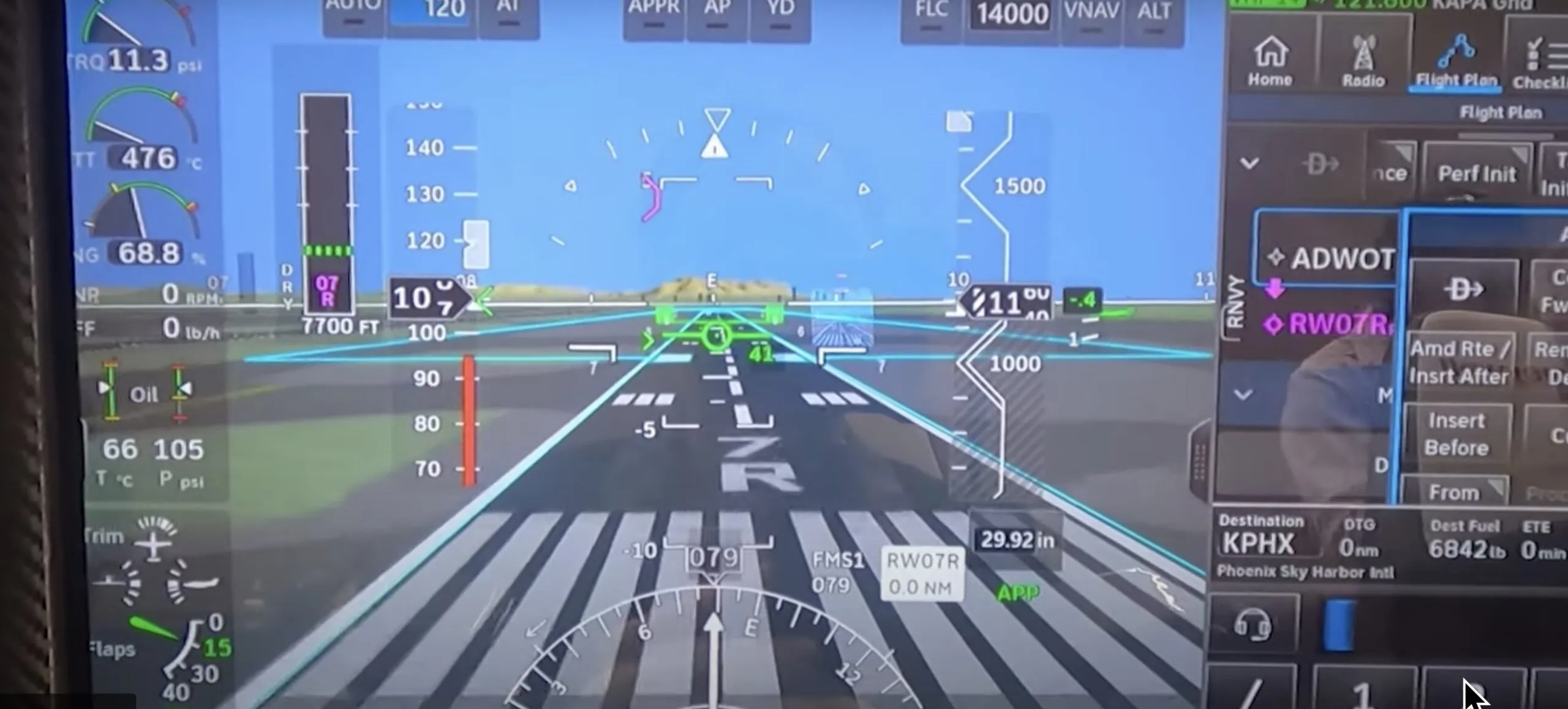Åpenbart et system med utviklingsmuligheter også for større fly. (Red.)
For me, the biggest and quietest news at last week’s NBAA-BACE convention in Las Vegas came from Honeywell, introducing its clean-sheet, cloud-connected Anthem integrated flight deck. I might have overlooked the announcement hadn’t my colleague Kate O’Connor asked for my camera hand to help capture this Anthem video. It was worth the effort.
A tip of the hat to product line director Jason Bialek, and the engineering effort behind Honeywell Anthem, which was demoed in a bezel-less five-screen touch display format with 2K resolution and cursor control device (CCD) command, plus super-mapping, engine-out glide assist, 3D runway overrun protection, autothrottle and autopilot (automatic landing is planned). From what I saw during the well-presented one-on-one demo of the system in a full-sized cockpit simulator, Anthem’s automotive-inspired ergos (think big-screen-equipped Tesla dashboard) looks to be one terrifically executed and smartly integrated avionics suite—more modern and capable than any other my jaded eyes have seen in 30 years of covering the market.
The new standard for integrated avionics, and the backbone of Anthem, is an agnostically connected cloud capability, where you can access the avionics in the airplane 24/7 to push flight plans (Honeywell was showing the ForeFlight desktop and mobile app interface capabilities), check engine and fuel vitals, load maintenance files, configure the screen layout and do other preflight chores without being anywhere near the aircraft. It’s a similar concept to what Cirrus is doing with Cirrus IQ, a cloud-based utility with a nifty mobile app interface so you can log in to the airplane remotely, while the aircraft transmits stored data to a cloud after each landing.
There’s a buzzkill. Anthem’s ability to earn sizable traction in both the forward-fit and retrofit market—it’s aimed at both, and aircraft large and small, plus UAVs—will depend almost entirely on the efforts of Honeywell’s marketing team. Out of the gate, the company isn’t using an outside agency, something I applaud. Call me old school, but it just drives me nuts when companies use outside marcom with often limited if any experience or knowledge of the industry and the tech it’s communicating about.
Post-show, all of my technical follow-ups have been answered quickly, thoroughly and honestly. But I don’t matter. It’s OEMs and a to-be-established dealer network Honeywell has to bring aboard the gravy train. These—and existing inked business deals with Garmin—are huge hurdles, in my estimation, and I’d imagine Honeywell fully understands this. Its strategy is anyone’s guess.
For starters, the company made it clear that Anthem is not a BendixKing product. That division of Honeywell, I was told, will for now remain in place to sell and support autopilots and repurposed products from a handful of third-party manufacturers. Still, Honeywell’s Anthem will eventually replace the AeroVue series, an integrated avionics system for certified and experimental applications that the company has invested sizably in, but with little traction in the aftermarket and at OEMs, both of which are heavily dominated by Garmin products, of course—too many to name in one sitting, so I won’t try.
The timing of the first round of anticipated certification (2025, or thereabouts, with no guarantees) won’t help. Neither will a choked supply chain. Consider that Garmin’s fully certified and proven G3000 and G5000 flight decks have gained sizable penetration in the forward-fit and retrofit bizjet and airliner market—an area that Honeywell for years has managed to serve, along with Collins Avionics and Universal Avionics. Moreover, Honeywell’s current Primus Epic 2.0 and Epic 2.0+ integrated avionics systems are far from bottom-barrel designs. Primus Epic is in the Pilatus PC-24 jet, and the Apex version of the Epic has been firmly planted in the PC-12NG/NGX turboprops, earning high marks for owner satisfaction and advanced mission capability. If you’ve used it, you’ll know that Honeywell’s Primus Epic for Gulfstream’s mighty PlaneView cockpit is no joke.
And from what I saw, neither is Honeywell’s Anthem, and it could very well change the way the industry approaches integrated avionics. The plans are lofty. The company says it will offer scalable versions for airplanes right down to Cessna Skyhawks, and also versions for the experimental homebuilt market. For the later crowd, I suggest prefab harnesses for a foolproof installation. As for OEM applications, in theory the potential is huge. You know the platforms—everything from Cirrus pistons and the Vision Jet, Piper’s M-series, Daher TBMs, and Embraers—to Textron pistons and turbines. These all currently sport Garmin glass. To succeed in those markets, they’ll need dealer network support and first-rate technical support, something Garmin has mastered.
It’s far too early to vouch for the system’s reliability and you can bet there will be growing pains—something Garmin has also mostly tamed. But at first blush, the Anthem seems so capable and a refreshing departure from the familiar that it would be a shame if it didn’t gain the shot it deserves for both retrofit and at least offered as an OEM option. I’m glad to be watching this one from the sidelines.






Ingen kommentarer:
Legg inn en kommentar
Merk: Bare medlemmer av denne bloggen kan legge inn en kommentar.